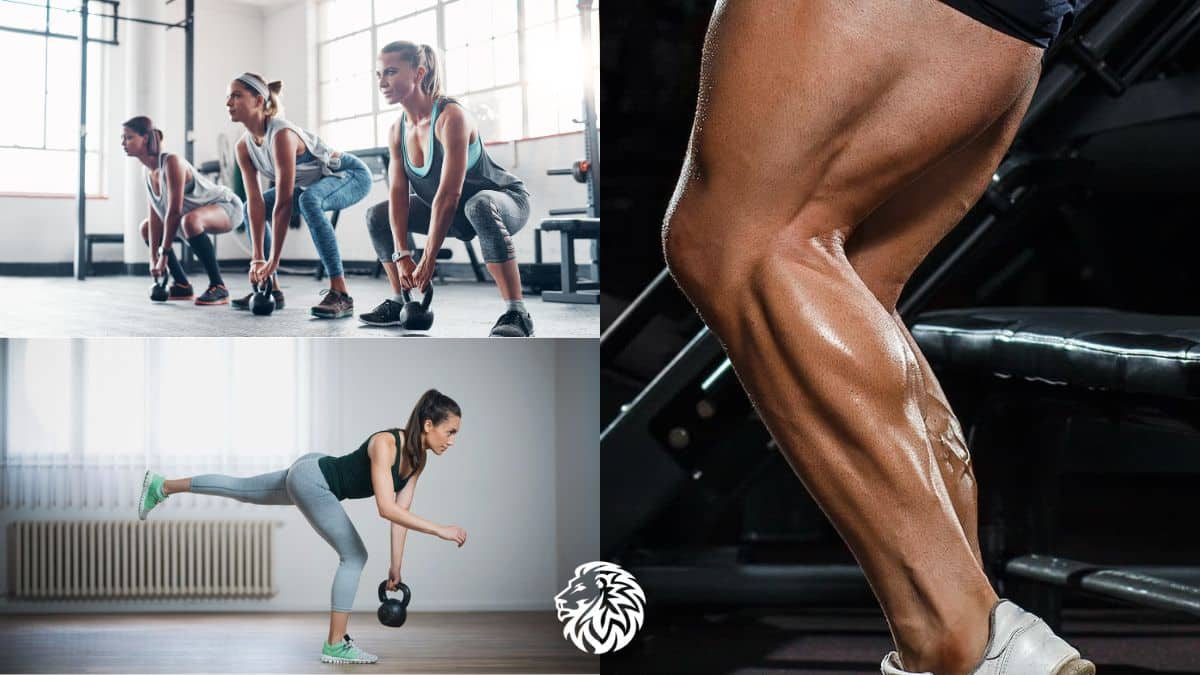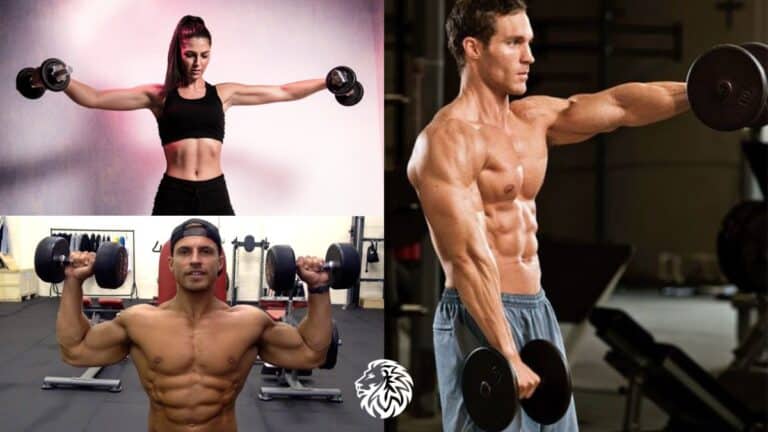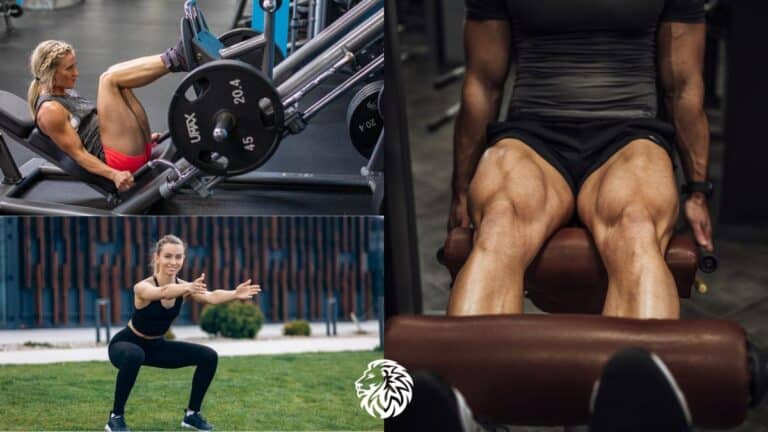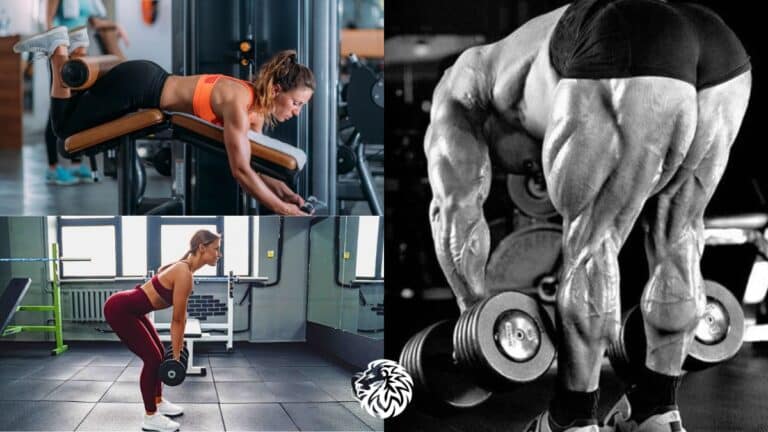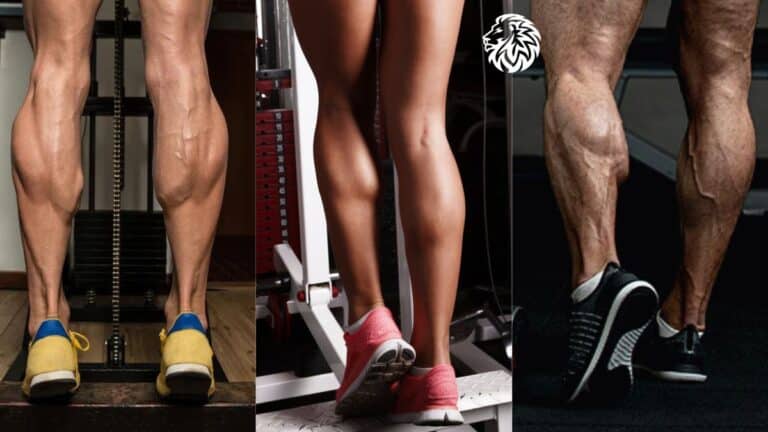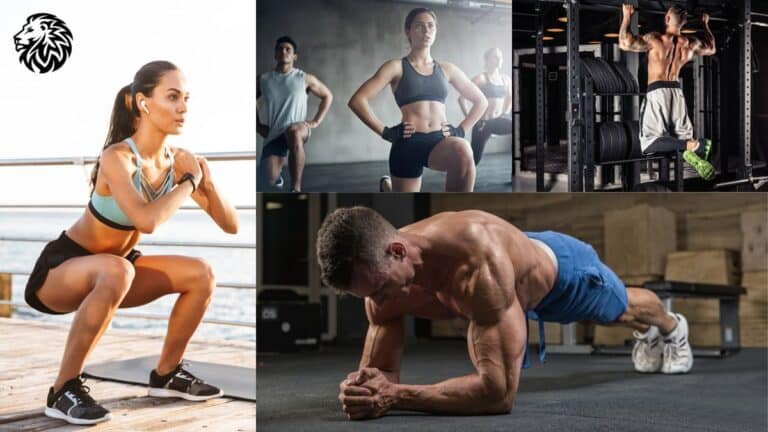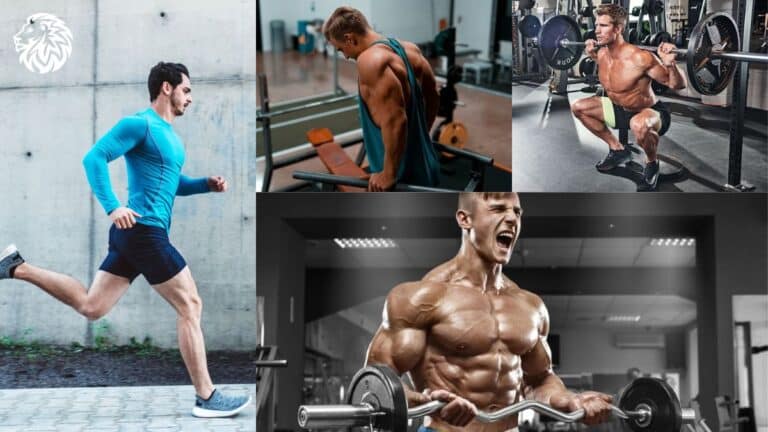Hamstring muscles, located at the back of the thigh, are critical for a myriad of daily activities such as walking, running, and jumping. They play a crucial role in overall fitness, stability, and athletic performance. The strength of these muscles is not just important for athletes; it’s vital for anyone looking to maintain a healthy and active lifestyle. Strengthening the hamstrings can help prevent injuries, improve posture, and enhance balance and coordination.
Incorporating hamstring exercises into your home workout routine offers numerous benefits. Firstly, it’s convenient and cost-effective, eliminating the need for a gym membership or expensive equipment. Home exercises provide flexibility in scheduling, allowing you to work out at your own pace and in the comfort of your own space. Additionally, focusing on hamstring strength at home can be particularly beneficial for those who spend long hours sitting, as it helps counteract the effects of prolonged inactivity.
This article will guide you through seven effective hamstring exercises that can be easily performed at home. These exercises range from simple stretches to more dynamic movements, ensuring a comprehensive approach to hamstring fitness. Whether you’re a fitness enthusiast or someone looking to enhance your physical well-being, these exercises are designed to be accessible, requiring minimal equipment and space. By the end of this article, you’ll have a variety of tools at your disposal to build stronger, healthier hamstrings right from the comfort of your home.
7 Strength Building Hamstring Exercises You Can Do at Home
Exercise 1: Romanian Deadlifts with Dumbbells
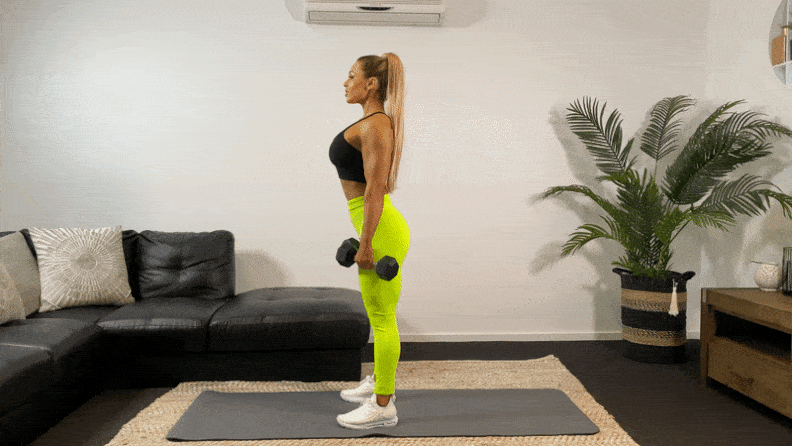
Description of the Exercise: Romanian Deadlifts (RDLs) with dumbbells are a highly effective strength-building exercise for the hamstrings. This exercise not only targets the hamstrings but also engages the glutes and lower back, making it a great compound movement. RDLs are particularly beneficial because they mimic everyday movements like bending and lifting, thus improving functional strength.
Step-by-Step Guide:
- Starting Position: Stand upright with your feet hip-width apart, holding a dumbbell in each hand in front of your thighs. Keep your arms straight, palms facing your body.
- Movement Initiation: Slightly bend your knees. Keeping your back straight, start hinging at your hips, pushing them backward.
- Lowering Phase: Lower the dumbbells close to the front of your legs, maintaining a slight bend in your knees. Keep your spine neutral and head in line with your spine. Lower down until you feel a stretch in your hamstrings or until your upper body is parallel to the floor, whichever comes first.
- Lifting Phase: Engage your hamstrings and glutes to return to the starting position. Keep the dumbbells close to your body throughout the movement.
- Repetition: Perform the desired number of reps, ensuring controlled movement throughout.
Tips for Maintaining Proper Form and Avoiding Injury:
- Keep Your Back Straight: Ensure your spine remains neutral throughout the exercise. Avoid rounding or arching your back, as this can put undue stress on your lower back.
- Move Through Your Hips: The motion should come from your hips moving backward and forward. Avoid bending excessively at the waist.
- Engage Your Core: Keep your abdominal muscles tight during the exercise to support your spine.
- Avoid Locking Your Knees: Maintain a slight bend in your knees throughout the movement to protect your joints and engage the correct muscles.
- Don’t Overstretch: Lower the weight only as far as your hamstring flexibility allows. Overstretching can lead to injury.
- Control the Weight: Use a weight that is challenging but allows you to perform the exercise with proper form. Avoid using momentum to lift the weight.
- Breathing: Exhale as you lift the dumbbells and inhale as you lower them.
- Progress Gradually: As you gain strength, you can gradually increase the weight of the dumbbells to continue challenging your muscles.
Incorporating Romanian Deadlifts into your home workout routine can significantly improve hamstring strength and overall lower body fitness.
Exercise 2: Single-Leg Deadlifts
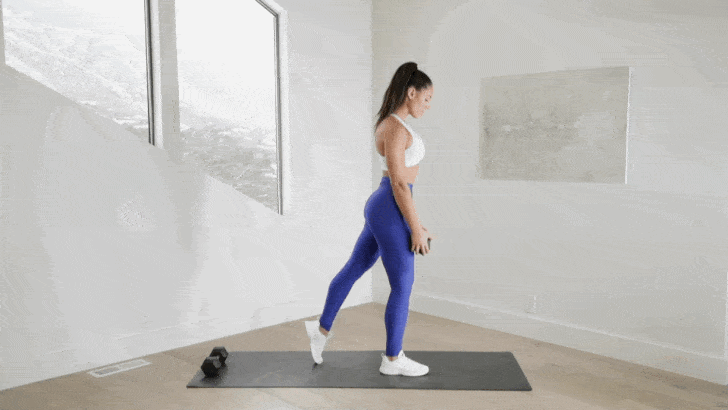
Explanation of How This Exercise Targets the Hamstrings: The Single-Leg Deadlift is a potent exercise that isolates and strengthens the hamstring muscles on each leg individually. By balancing on one leg, this exercise not only challenges the hamstrings but also enhances balance and core stability. The movement involves hip hinging, similar to the Romanian Deadlift, but with an added balance component, placing more demand on the hamstring of the standing leg.
Detailed Instructions for Performing the Exercise:
- Starting Position: Stand upright with your feet together. Hold a light dumbbell in your right hand (optional) and shift your weight onto your left foot.
- Balance and Hinge: Lift your right foot slightly off the ground. Keeping your left knee slightly bent, hinge forward at the hips, extending your right leg straight behind you. Your body should form a ‘T’ shape, with your right leg, back, and head in a straight line.
- Lowering Phase: As you hinge forward, lower the dumbbell towards the ground, keeping your hips square and your right leg in line with your body. Go down as far as your flexibility allows without compromising form.
- Lifting Phase: Squeeze your left hamstring and glute to return to the upright position, keeping your balance throughout the movement.
- Repetition: Complete the desired number of reps on one leg before switching to the other.
Variations for Beginners or Those with Limited Balance:
- Touchdown for Balance: If maintaining balance is challenging, allow the toes of your raised leg to lightly touch the ground as you lower your body.
- Use a Wall for Support: Perform the exercise next to a wall. Lightly touch the wall with one hand for balance as needed.
- Reduce Range of Motion: Instead of lowering all the way to form a ‘T’ shape, only hinge forward slightly until you feel your hamstrings engage, then return to the starting position.
- Bodyweight Only: Beginners can perform this exercise without weights, focusing solely on the movement and balance aspects.
- Slow and Controlled Movements: Perform the exercise slowly to enhance balance and muscle engagement.
Single-Leg Deadlifts are excellent for developing unilateral strength and stability, making them a valuable addition to any home workout routine focused on hamstring development.
Exercise 3: Stability Ball Hamstring Curls
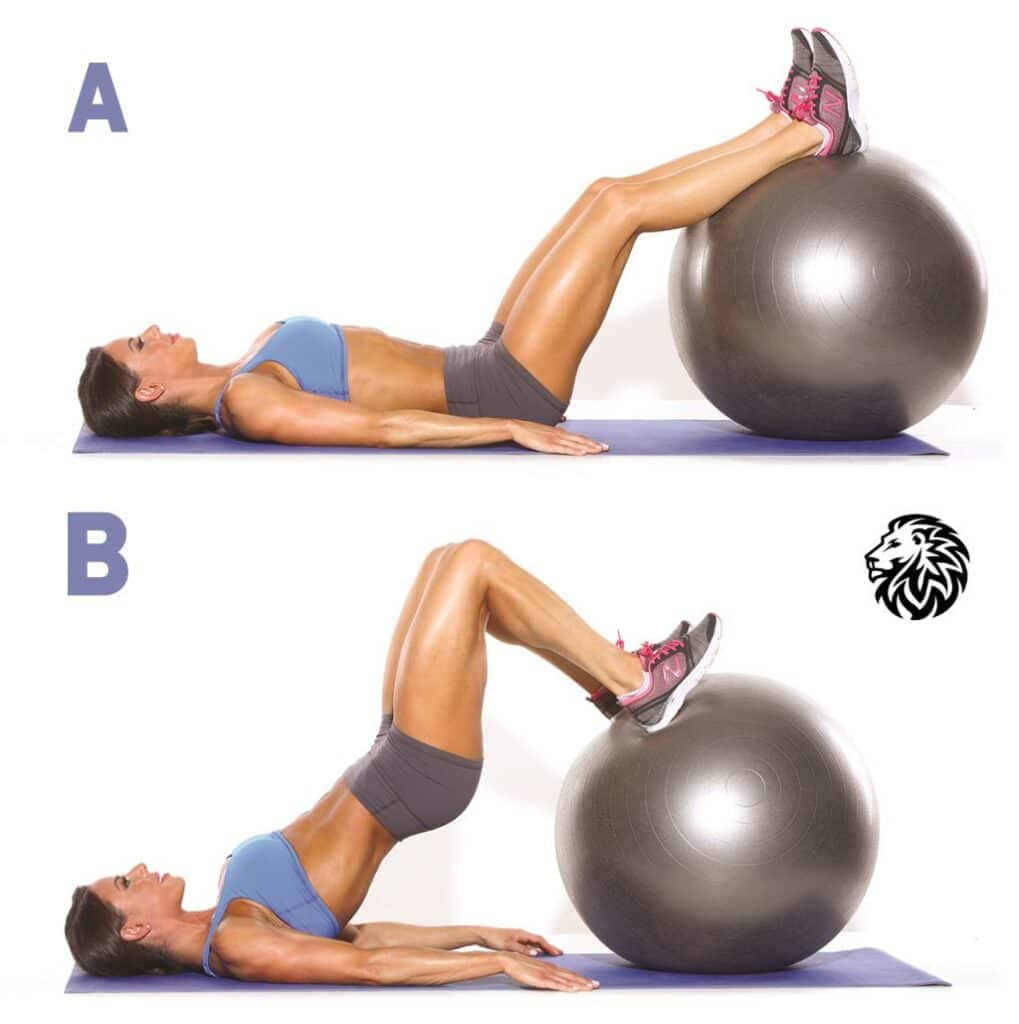
Introduction to Using a Stability Ball for Hamstring Workouts: Stability balls, also known as exercise balls, are versatile tools for enhancing workouts, especially for targeting the hamstrings. When used for hamstring curls, the stability ball introduces an element of balance and instability, which forces additional muscle groups to engage, particularly the core and stabilizer muscles in the legs.
Procedure for Executing the Curls Effectively:
- Starting Position: Begin by lying flat on your back on a mat, with your arms extended by your sides for balance. Place your heels on top of the stability ball, legs straight.
- Engage and Lift: Tighten your core and glutes, then lift your hips off the ground to form a straight line from your shoulders to your feet.
- Curling Movement: While keeping your hips elevated, bend your knees to roll the ball towards your body, bringing your heels as close to your buttocks as possible.
- Extension: Slowly straighten your legs, rolling the ball back to the starting position, while maintaining a lifted and stable hip position.
- Repetition: Perform the desired number of repetitions, maintaining control and stability throughout the exercise.
Advantages of This Exercise for Core Stability:
- Enhanced Core Engagement: The instability of the stability ball requires significant core engagement to maintain balance and proper form, leading to stronger abdominal and lower back muscles.
- Improved Balance and Coordination: Regularly performing stability ball hamstring curls can enhance overall balance and coordination, as it trains the body to stabilize while performing the curling motion.
- Full Hamstring Activation: This exercise effectively targets the entire hamstring muscle group, promoting strength and flexibility.
- Versatile Difficulty Levels: The exercise can be modified to increase or decrease difficulty, making it suitable for various fitness levels. For instance, lifting one leg off the ball while performing the curl increases the challenge.
- Low Impact on Joints: Stability ball exercises are generally low impact, reducing the risk of injury and making them a safe choice for people with joint concerns.
Incorporating stability ball hamstring curls into your home workout regimen can significantly enhance hamstring strength, improve core stability, and contribute to overall lower body fitness.
Exercise 4: Glute Bridges with Hamstring Emphasis
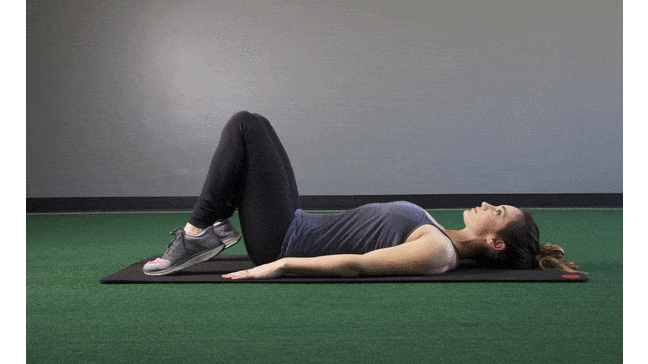
Description of the Exercise and Its Benefits: Glute Bridges with a hamstring emphasis are a fundamental exercise that targets the hamstrings, glutes, and lower back. This exercise is beneficial for improving hip mobility, strengthening the posterior chain, and can aid in reducing lower back pain. By focusing on the hamstrings, you can also improve your performance in activities that involve running, jumping, and squatting.
Instructions for Proper Form and Execution:
- Starting Position: Lie on your back on a mat with your knees bent, feet flat on the floor, and arms by your sides. Your feet should be hip-width apart and close enough to your buttocks.
- Lift and Squeeze: Push through your heels to lift your hips towards the ceiling. Squeeze your glutes and hamstrings at the top of the movement, ensuring your body forms a straight line from your knees to your shoulders.
- Hold: Briefly hold the bridge position, maintaining the muscle squeeze, for a couple of seconds.
- Lower Down: Slowly lower your hips back to the starting position without fully resting on the floor between repetitions.
- Repetition: Perform the desired number of reps, maintaining a controlled movement throughout.
Variations for Increased Intensity:
- Single-Leg Bridge: Lift one foot off the ground, extending the leg straight out in line with your thigh. Perform the bridge using only one leg for support. This variation significantly increases the intensity on the hamstrings of the supporting leg.
- Elevated Feet: Place your feet on a raised surface, such as a step or a low bench, to increase the range of motion and intensity.
- Stability Ball: Perform the bridge with your feet on a stability ball. This not only intensifies the hamstring engagement but also adds a stability challenge.
- Weighted Bridge: For added resistance, place a dumbbell or weight plate on your hips.
- Pulsing Glute Bridge: Instead of holding at the top, perform small pulses to maintain constant tension on the hamstrings and glutes.
Glute Bridges with a focus on the hamstrings are a versatile and effective exercise for strengthening the lower body and improving core stability. They are particularly useful for those looking to enhance their hamstring strength and overall lower body power.
Exercise 5: Resistance Band Leg Curls
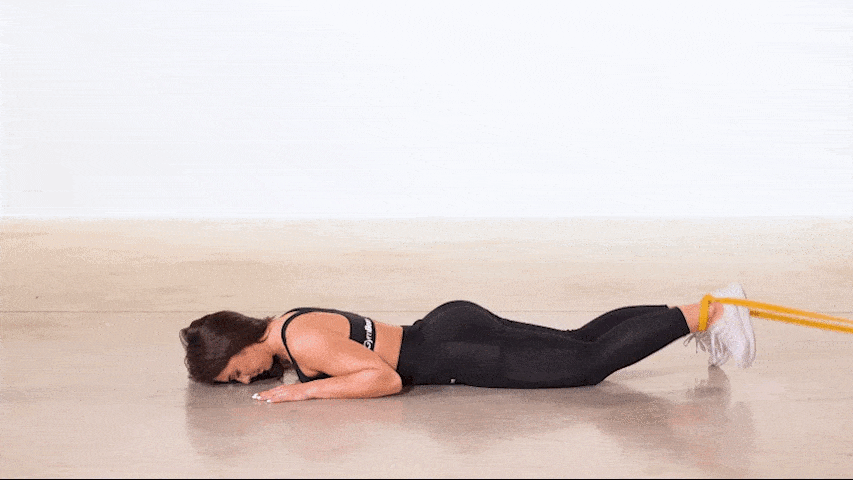
Utilizing Resistance Bands for Hamstring Strength: Resistance bands are a fantastic tool for hamstring development, offering a versatile and adaptable way to increase strength. Leg curls with a resistance band provide targeted hamstring engagement. The unique tension from the bands creates a dynamic resistance that changes throughout the movement, challenging the muscles in a different way compared to traditional weights.
Step-by-Step Guide to Performing Leg Curls with a Band:
- Setup: Begin by securing one end of the resistance band to a low, stable anchor point near the ground. Lay face down on a mat, with the anchor point behind you.
- Band Positioning: Loop the other end of the band around your ankles. You can do this exercise one leg at a time or with both legs together, depending on the length and strength of the band.
- Starting Position: With your legs straight, position yourself far enough away from the anchor point so that the band is slightly stretched, creating tension.
- Curling Movement: Flex your knees to pull your heels towards your buttocks, keeping your hips firmly pressed against the mat. The resistance band will provide opposition as you curl.
- Extension: Slowly extend your legs back to the starting position, controlling the movement against the resistance of the band.
- Repetition: Perform the desired number of repetitions, maintaining a consistent tempo and controlled movements.
How to Adjust Resistance for Different Fitness Levels:
- Change Band Strength: Resistance bands come in various strengths, indicated by their thickness and color. Use a lighter band for less resistance or a thicker band for more.
- Adjust Band Length: Shortening the band (by looping it more around your ankles or the anchor point) increases tension, while lengthening it decreases tension.
- Alter Starting Position: Moving closer to the anchor point reduces resistance, while moving further away increases it.
- Control the Pace: Performing the curls more slowly increases the difficulty, while a faster pace may reduce the intensity.
- Increase Repetitions or Sets: For a greater challenge, increase the number of repetitions or sets.
Resistance band leg curls are an effective way to strengthen hamstrings at home, offering the flexibility to adjust the intensity based on individual fitness levels. This exercise is particularly beneficial for those who require adaptable resistance levels or who are looking for a low-impact alternative to weights.
Exercise 6: Nordic Hamstring Curls
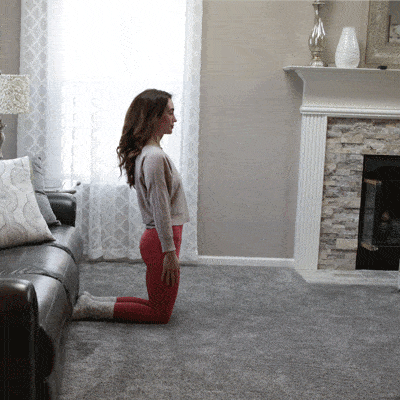
Explanation of This Challenging Exercise: Nordic Hamstring Curls are a highly effective and challenging exercise that primarily targets the hamstrings. This exercise is known for its intensity and ability to significantly strengthen and build the hamstring muscles. It involves a controlled lowering of the body from a kneeling position, using the hamstrings to resist the motion, followed by a return to the starting position. Due to its difficulty, it’s often considered an advanced exercise.
Detailed Instructions for Safe and Effective Performance:
- Setup: Begin by securing your feet. You can use a Nordic hamstring curl machine, if available, or have a partner hold your ankles. Alternatively, you can secure your feet under a heavy piece of furniture or any stable object.
- Starting Position: Kneel on a padded surface with your feet secured. Keep your hips extended and your body in a straight line from your knees to your shoulders.
- Lowering Phase: Slowly lean forward, leading with your hips, and keep your body straight. Use your hamstrings to control the descent as much as possible. Extend your arms forward to brace for the landing.
- The Bottom Position: Go as low as you can while maintaining control. If you’re a beginner, this might be a relatively short range.
- Return to Starting Position: Push yourself back up to the kneeling position. Beginners can use their arms to assist in pushing back up.
Suggestions for Beginners to Modify the Exercise:
- Reduced Range of Motion: Start with a smaller range of motion, going only part of the way down, then gradually increase as your strength improves.
- Use of Assistance: Beginners can use resistance bands for assistance. Attach a band to a sturdy overhead object and hold onto it for support as you lower and raise your body.
- Eccentric Focus: Focus on the lowering (eccentric) phase, then use your hands to push yourself back up to the starting position.
- Spotter Assistance: Have a spotter support you under your torso, helping to control the descent and assist in the return phase.
Nordic Hamstring Curls are a potent exercise for developing hamstring strength and resilience. While challenging, they can be modified to suit different fitness levels, making them an invaluable addition to a comprehensive hamstring strengthening routine.
Exercise 7: Slider Leg Curls
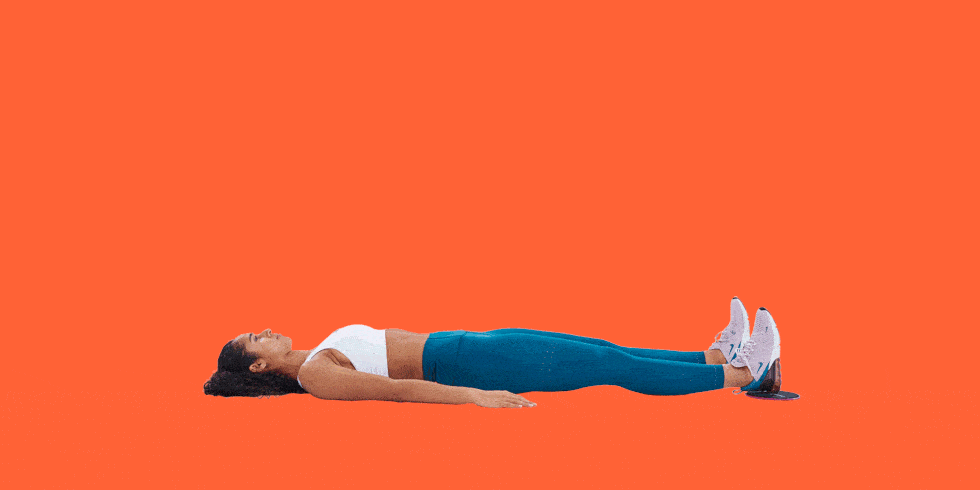
Use of Sliders or Towels for a Home-Based Workout: Slider Leg Curls are a resourceful and effective way to target the hamstrings using minimal equipment. This exercise can be performed at home using either furniture sliders or towels (on a smooth surface like hardwood or tile floors). The sliding motion creates a unique challenge, engaging the hamstrings intensely as they work to control the movement.
Technique for Performing the Curls Correctly:
- Setup: Lie on your back on a mat with your knees bent and feet placed on sliders or towels. Your arms should be at your sides for stability.
- Starting Position: Lift your hips off the floor, entering a bridge position. Engage your core and glutes to maintain stability.
- Sliding Movement: Slowly extend your legs, sliding your feet away from your body while keeping your hips elevated. Extend as far as you can while maintaining hip elevation.
- Curling Phase: Using your hamstrings, pull your feet back towards your body, returning to the bridge position. Keep the movement controlled and steady.
- Repetition: Perform the desired number of repetitions, ensuring consistent form throughout the exercise.
Benefits of This Exercise for Hamstring and Core Strength:
- Hamstring Activation: Slider Leg Curls provide intense focus on the hamstrings, as they work to control both the extension and curling motion, leading to increased strength and muscle endurance.
- Core Engagement: Maintaining the bridge position requires significant core strength, thus improving overall core stability and strength.
- Low Impact: This exercise is low impact, making it suitable for those with joint issues or for recovery days.
- Balance and Coordination: The need to control the sliding motion enhances your balance and coordination skills.
- Versatility and Convenience: This exercise can be easily modified for intensity and is convenient for home workouts, requiring only simple equipment.
Slider Leg Curls are an excellent addition to any home workout routine, offering a unique and effective way to strengthen the hamstrings and core with minimal equipment.
Safety Tips and Injury Prevention
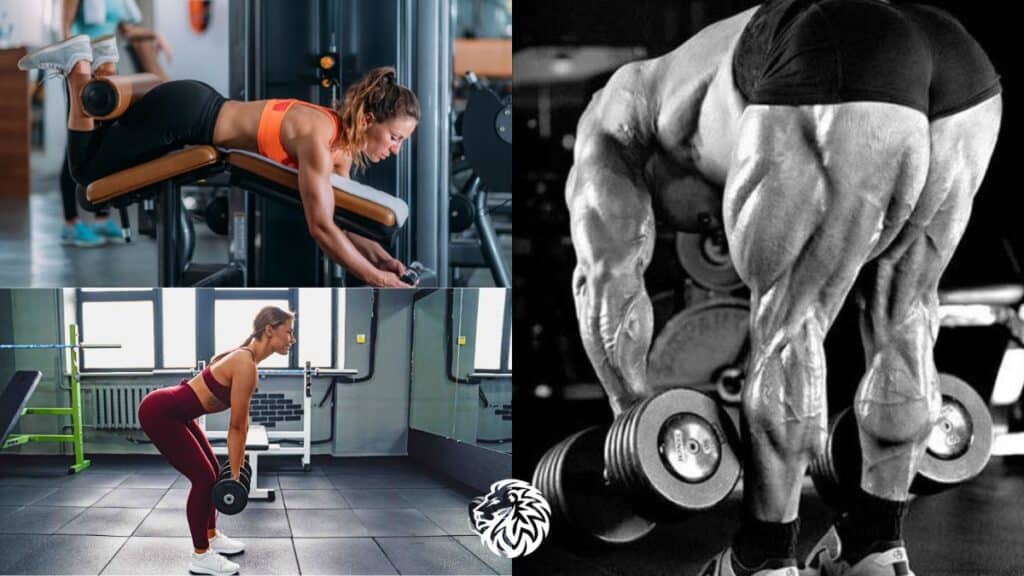
Importance of Warming Up Before Exercising:
- Prepares Muscles and Joints: A proper warm-up increases blood flow to the muscles and loosens the joints, which prepares your body for the physical stress of exercise.
- Reduces Injury Risk: Warming up helps reduce the risk of muscle strains and joint injuries by increasing muscle elasticity.
- Improves Performance: It can enhance your performance by increasing your heart rate and body temperature, making muscles more responsive.
- Dynamic Stretching: Incorporate dynamic stretches and light cardio (like jogging in place or jumping jacks) for 5-10 minutes before starting your hamstring exercises.
How to Recognize and Avoid Common Hamstring Workout Mistakes:
- Overstretching: Be cautious not to overstretch your hamstrings. Always move within your comfortable range of motion.
- Improper Form: Pay attention to form. Poor form not only reduces the effectiveness of the exercise but also increases injury risk. Consider recording yourself or using a mirror to check your form.
- Rushing Through Reps: Avoid rushing through the exercises. Slow and controlled movements ensure better muscle engagement and prevent strain.
- Ignoring Pain: Listen to your body. Discomfort is normal, but sharp pain is a warning sign. Stop exercising if you experience pain.
When to Modify Exercises to Suit Individual Needs and Fitness Levels:
- Beginners: Start with simpler, low-intensity versions of exercises and gradually progress to more challenging variations.
- Limited Mobility or Balance: Use modifications, like reduced range of motion or assistance (like holding onto a chair), to perform exercises safely.
- Recovering from Injury: If you’re recovering from an injury, consult with a healthcare provider or physical therapist to understand which exercises are safe and beneficial.
- Fatigue or Muscle Soreness: If muscles are sore or fatigued, reduce the intensity of the workout or take an extra rest day to allow for recovery.
- Age and Health Considerations: Older adults or individuals with health issues should modify exercises to lower intensity and impact, focusing on maintaining mobility and preventing injury.
Remember, the key to effective and safe workouts is to understand and respect your body’s limits, gradually pushing them in a controlled and mindful manner. Regular practice, combined with proper form and modifications as needed, will lead to steady and safe progress in hamstring strength and overall fitness.
Conclusion
The seven hamstring exercises we’ve discussed offer a comprehensive approach to strengthening and conditioning these vital muscles. From Romanian Deadlifts with Dumbbells to Slider Leg Curls, each exercise targets the hamstrings in a unique way, promoting strength, flexibility, and overall lower body health. The incorporation of equipment like stability balls and resistance bands adds variety and challenge to your workouts, making them both effective and engaging.
The benefits of these exercises extend beyond just stronger hamstrings. They contribute to better posture, improved balance, enhanced athletic performance, and a reduced risk of injuries, especially in the lower back and knees. Furthermore, these exercises have been designed to be accessible and doable at home, making it easier for you to integrate them into your regular fitness routine.
I encourage you to make these hamstring exercises a consistent part of your workout regimen. Consistency is key in seeing progress and achieving results. Remember, it’s not just about how often you exercise, but also how you exercise. Proper form is crucial in ensuring the effectiveness of the workouts and in preventing injuries. Take time to understand each movement, start with a level that suits your current fitness, and gradually increase the intensity as you get stronger.
By incorporating these hamstring exercises into your fitness journey, you’ll be taking a significant step towards better health and fitness. Stay committed, be patient with your progress, and enjoy the journey towards a stronger, healthier you.
References and Further Reading
- TrainHeroic. (n.d.). Best hamstring exercises. TrainHeroic. Retrieved from https://www.trainheroic.com/blog/best-hamstring-exercises/
- Built With Science. (n.d.). Best compound hamstring exercises. Built With Science. Retrieved from https://builtwithscience.com/fitness-tips/best-compound-hamstring-exercises/
- American Council on Exercise. (2018, February). ACE-sponsored research: What is the best exercise for the hamstrings? ACE Fitness. Retrieved from https://www.acefitness.org/continuing-education/certified/february-2018/6896/ace-sponsored-research-what-is-the-best-exercise-for-the-hamstrings/
- Real Simple. (n.d.). Hamstring exercises and stretches. Real Simple. Retrieved from https://www.realsimple.com/health/fitness-exercise/workouts/hamstring-exercises-stretches
- Northeast Texas Community College. (n.d.). Hamstring exercises. NTCC. Retrieved from https://www.ntcc.edu/athletics/live-athlete/exercises/hamstring-exercises
